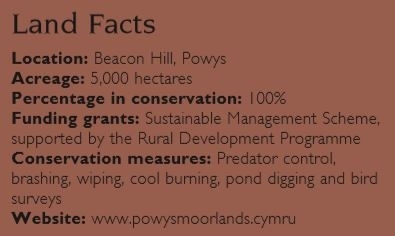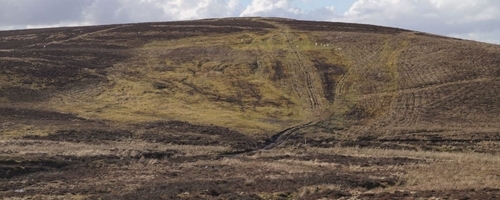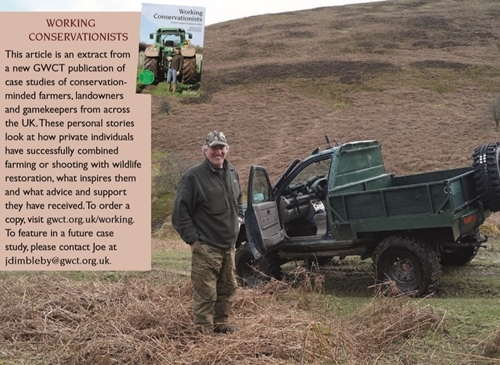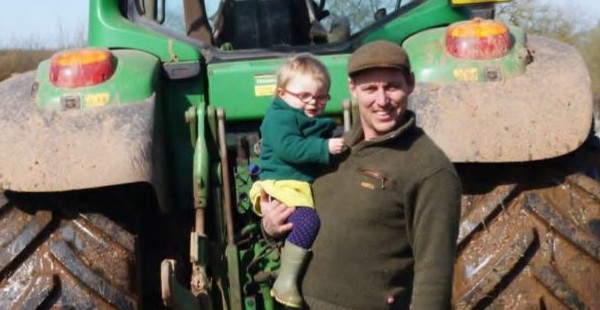David Thomas is a gamekeeper on Beacon Hill moor, 5,000 acres of the Crown Estate near Pilleth in Powys, the site of Owain Glyndwr’s famous defeat of the English at the battle of Bryn Glas. The land is grazed by sheep farmers who hold commons’ rights and the shooting rights are rented by a local syndicate captained by Peter Hood, a retired hill farmer. David’s post is funded by the Welsh Government (WG) as part of the Powys Moorland Partnership which includes three separate moors aiming to restore grouse and other endangered moorland birds.

In the nineteenth century, Beacon Hill was a prodigious grouse moor. You can see the remains of a grand Victorian shooting lodge on the hillside and there was even a railway station to bring guests to the moor by train. These days the grouse are clinging on at about 30 brace and other moorland species have been similarly reduced.The reasons are complex.
Since the 1960s as the great estates disappeared, many of the Welsh uplands were ploughed or planted with woods and the remaining heather moors became isolated. In the 1970s Common Agricultural Policy (CAP) headage payments were introduced, which meant farmers received subsidies according to the number of sheep on their land. As a result, the moors were overgrazed, leaving birds little, food, nesting habitat or shelter. Since headage ended, the transformation has been dramatic, with heather and bracken returning.
Sheep grazing still plays a crucial role in keeping down scrub and the farmers are supportive and keen to make the project a success. It helps that David and Peter were both sheep farmers. Peter said: “The farmers have a soft spot for the hills and the wildlife and they are also tickled pink by the crow control David has achieved.”
David’s principal challenge is predation. There is no other keepering within 15 miles, so any vacuum created on the hill is quickly filled and covering 5,000 acres on his own is a big challenge. GWCT approved snares are an essential tool and a nightvision rifle scope is invaluable. If he is after a particular fox, David regularly stays up several nights in succession and said: “I’m currently putting in an 80-hour week. This winter I’ve accounted for 85 foxes up here and each year I get more, but it’s still the tip of the iceberg.”
In addition to foxes, he controls carrion crows by means of Larsen and ladder traps and has caught about 2,700 in the past three years. His trapping line, which includes tunnel traps for stoats, weasels and rats takes five hours to check every morning. Thanks to his efforts, grouse are more widespread and on one part of the moor numbers have trebled. Other bird species are making a more rapid recovery including mistle thrushes, skylarks and cuckoos, which can now be heard in profusion in spring. Hare numbers have boomed and so too have kestrels and merlins.
Another endangered species to have benefited is the curlew. David said: “We have managed to increase curlew broods on the hill, which I am delighted by. When you hear the bird’s call on the moor at the end of February, it’s the first sign of spring.”

Grass is returning to an area of bracken that David wiped with herbicide last year, creating a more diverse habitat on this part of the hill.

David’s custom-made all-terrain vehicle is essential in covering the 5,000 acres of ground.
A large part of David’s work is restoring a balance of habitat by creating a patchwork of heather, bracken, white grass and moss as well as digging ponds to provide water for grouse and to attract insects. Bracken is controlled with herbicide, younger heather can be brashed (cut), but the older, leggier areas show far better restoration through burning. David has initiated a 10-year rotation of areas of cool burn to avoid damaging the moss and peat underneath.
Members of the shoot volunteer their time to lend a hand with brashing and burning. They release a few redleg partridges every year for two informal shoot days. Peter, whose family has held the shooting rights since 1950, explained: “Our way of shooting is very unusual it’s similar to a family picnic. Wives and children come out on ponies and we drive the ground, it’s more like a grouse count.” In the 1960s the syndicate had eight days with an average bag of 15 brace on each, whereas this year they limited the whole season’s bag to three grouse. The aim is eventually to fund David’s work through one or two let days per year. There is still a way to go, but the syndicate is fully supportive of the broader conservation project and happy to keep going until grouse numbers return.
David said: “I want to see viable grouse shooting back in Wales with all the benefits to the other groundnesting birds that brings. As the WG has backed the project with considerable investment, I want it to repay their trust and to show that shooting can fund great conservation work.”

This 48-page A4-size colour publication features a series of case studies produced by the GWCT, focusing on the land managers who are helping to save British wildlife. It is a celebration of private stewardship and how passion and hard work can bring real benefits for the environment, wildlife and overall biodiversity. Available for just £3.95.
Buy Now >